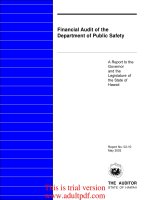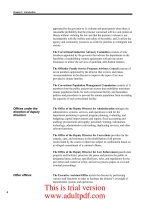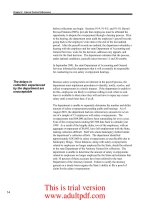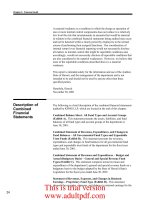modeling of frp-jacketed rc columns subject to combined axial and lateral loads
Bạn đang xem bản rút gọn của tài liệu. Xem và tải ngay bản đầy đủ của tài liệu tại đây (5.26 MB, 329 trang )
i
UNIVERSITY OF CALIFORNIA, SAN DIEGO
Modeling of FRP-Jacketed RC Columns
Subject to Combined Axial and Lateral Loads
A dissertation submitted in partial satisfaction of the
requirements for the degree Doctor of Philosophy
in
Structural Engineering
by
Chung-Sheng Lee
Committee in Charge:
Professor Gilbert A. Hegemier, Chair
Professor David Benson
Professor Vitali Nesterenko
Professor Frieder Seible
Professor Chia-Ming Uang
2006
UMI Number: 3211782
3211782
2006
Copyright 2006 by
Lee, Chung-Sheng
UMI Microform
Copyright
All rights reserved. This microform edition is protected against
unauthorized copying under Title 17, United States Code.
ProQuest Information and Learning Company
300 North Zeeb Road
P.O. Box 1346
Ann Arbor, MI 48106-1346
All rights reserved.
by ProQuest Information and Learning Company.
ii
Copyright
Chung-Sheng Lee, 2006
All rights reserved.
iv
“The fear of the LORD is the beginning of wisdom.”
Proverbs, 9:10a
v
TABLE OF CONTENTS
SIGNATURE PAGE iii
TABLE OF CONTENTS v
LIST OF SYMBOLS xii
LIST OF FIGURES xix
LIST OF TABLES xxvi
ACKNOWLEDGMENTS xxviii
VITA, PUBLICATIONS AND FIELDS OF STUDY xxix
ABSTRACT OF THE DISSERTATION xxxii
CHAPTER 1. INTRODUCTION 1
1.1 BACKGROUND 1
1.2 FRP OVERLAY TECHNIQUE 7
1.3 CONFINED CONCRETE BEHAVIOR 8
1.4 EVALUATION OF STRUCTURAL RESPONSE UNDER BLAST LOAD
(EQUIVALENT SINGLE-DEGREE-OF-FREEDOM SYSTEM) 10
1.5 PROBLEM STATEMENT AND RESEARCH OBJECTIVES 13
1.6 DISSERTATION ORGANIZATION 15
CHAPTER 2. MODEL OF FRP-CONFINED CONCRETE CYLINDERS
UNDER AXIAL COMPRESSION 17
2.1 I
NTRODUCTION 17
2.1.1 Review of Existing Model Development 18
2.1.2 “Actual” Stain-Softening Response of Concrete in Uniaxial
Compression 20
2.1.3 Unconfined Model by Pantazopoulou and Mills [54] 24
2.2 S
TUDY APPROACH AND SIGNIFICANCE 27
2.3 “ACTUAL” RESPONSES OF CONCRETE IN UNIAXIAL COMPRESSION 28
2.3.1 Basic Concrete Properties 28
2.3.2 Parametric Formula for
β
and
ε
clim
29
2.3.3 Determination of Parameter C 30
vi
2.3.4 Validity of Modified P&M Model Predictions 33
2.4 P
ROPOSED FRP-CONFINED CONCRETE MODEL 36
2.4.1 Axial Secant Stiffness of FRP-Confined Concrete 38
2.4.2 Confinement Effectiveness and Confinement Ratio 40
2.4.3 Implementation of Proposed Model 43
2.5 V
ALIDATION OF PROPOSED MODEL 46
2.5.1 Tests by Picher et al. [58] 48
2.5.2 Tests by Mastrapa [42] 49
2.5.3 Tests by Owen [52] 51
2.5.4 Tests by Xiao and Wu [88] 53
2.5.5 Tests by Rochette and Labossière [66] 55
2.5.6 Tests by Dias da Silva and Santos [13] 56
2.5.7 Performance of Ultimate Axial Strength and Strain Predictions 57
2.6 EXPLICITLY EXPRESSION FOR ULTIMATE AXIAL STRENGTH AND STRAIN 66
2.6.1 Validation and Accuracy 68
2.6.2 Axial Responses vs. Confining Stiffness 71
2.7 SUMMARY AND CONCLUSIONS 73
CHAPTER 3. MODEL OF RECTANGULAR FRP-CONFINED
CONCRETE UNDER AXIAL COMPRESSION 76
3.1 INTRODUCTION 76
3.2 E
XISTING STUDIES ON FRP-CONFINED CONCRETE IN RECTANGULAR
SECTIONS 77
3.2.1 Experimental Stress-Strain Relations 77
3.2.2 Deformation of FRP Jacket 79
3.2.3 Existing Models for Rectangular FRP-Confined Concrete Columns 81
3.2.3.1 Confinement Mechanism of FRP Jacket in Rectangular Section 81
3.2.3.2 Existing Model Approaches 82
3.3 N
EW MODEL FOR RECTANGULAR FRP-CONFINED CONCRETE IN AXIAL
COMPRESSION 84
3.3.1 Effective Confined Area 84
vii
3.3.2 Model of Rectangular FRP-Confined Concrete in Axial
Compression 86
3.3.3 Approximate Evaluation of Transverse Strains 88
3.3.4 Approximate Evaluation of Hoop Jacket Strains 90
3.3.4.1 Hoop Jacket Strain on Flat Parts 91
3.3.4.2 Hoop Jacket Strain in Corner Zones 92
3.4 MODEL VALIDATION 95
3.4.1 Tests by SEQAD [73] 97
3.4.2 Tests by Hosotani et al. [23] 98
3.4.3 Tests by Pico [59] 99
3.4.4 Tests by Rochette and Labossière [65][66] 100
3.4.5 Tests by Masia et al. [41] 103
3.4.6 Tests by Rocca et al. [64] 105
3.4.7 Comparison of Maximum Jacket Strain Predictions 109
3.5 PARAMETRIC STUDY 114
3.5.1 Effect of Corner Radius on Stress-Strain Relation 114
3.5.2 Effect of Jacket Thickness on Axial Responses 115
3.6 SUMMARY AND DISCUSSIONS 119
CHAPTER 4. LOAD-DISPLACEMENT MODEL OF FRP-JACKETED
RC COLUMNS UNDER SEISMIC LOADS 122
4.1 I
NTRODUCTION 122
4.2 C
ONSTITUTIVE MODELS FOR MATERIALS 123
4.2.1 Cover Concrete in Compression 123
4.2.2 Concrete in Tension 124
4.2.3 Steel Reinforcement 125
4.3 M
OMENT-CURVATURE ANALYSIS 126
4.3.1 Segments of Column Section 128
4.3.2 Section Analysis 131
4.3.2.1 Neutral Axis Location 131
4.3.2.2 Cracking Moment, M
cr
132
viii
4.3.2.3 First-Yield Moment, M
y
133
4.3.2.4 Idealized-Yield Moment, M
i
134
4.3.2.5 Ultimate Moment, M
u
134
4.3.3 Validity of Moment-Curvature Curves 136
4.4 REVIEW OF DISPLACEMENT ASSESSMENT ON DOUBLE BENDING
COLUMNS 141
4.4.1 First-Yield Displacement 143
4.4.2 Idealized-Yield Displacement 144
4.4.3 Post-Yield Displacement 144
4.5 REVIEW OF UCSD SHEAR STRENGTH MODEL 146
4.5.1 Concrete Mechanism Strength, V
c
146
4.5.2 Steel Truss-Mechanism Component, V
s
149
4.5.3 Axial Load Shear Contribution, V
p
150
4.5.4 FRP Jacket Contribution, V
j
151
4.6 RESIDUAL SHEAR MODEL FOR FRP JACKET AND STEEL HOOP
CONTRIBUTIONS 151
4.7 MODEL CALIBRATIONS ON FRP-JACKETED CIRCULAR COLUMNS UNDER
DOUBLE BENDING 153
4.7.1 Moment-Curvature Responses 157
4.7.2 Hoop Jacket Strain-Curvature Curves 159
4.7.3 Revised Plastic Hinge Length 160
4.7.4 Load-Displacement Predictions 163
4.7.5 Shear Strength Analysis 165
4.8 L
OAD-DISPLACEMENT ANALYSIS OF CFRP-JACKETED RECTANGULAR
COLUMN UNDER SINGLE BENDING 167
4.9 SUMMARY AND CONCLUSIONS 173
CHAPTER 5. COMBINED AXIAL AND LATERAL LOAD TESTS OF
CFRP JACKETED RC COLUMNS (SIMULATED BLAST
LOADS) 174
5.1 I
NTRODUCTION 174
5.2 COLUMN SPECIMENS AND FRP JACKETS 176
ix
5.3 MATERIAL PROPERTIES 180
5.3.1 Concrete 180
5.3.2 FRP Jackets 181
5.3.3 Steel Reinforcement 181
5.4 TEST SETUP, INSTRUMENTATION AND TESTING PROCEDURE 182
5.4.1 Test Setup 182
5.4.2 Instrumentation 186
5.4.3 Testing Procedure 186
5.5 OBSERVED BEHAVIOR AND EXPERIMENTAL RESULTS 187
5.5.1 Overall Response 187
5.5.2 Lateral Deflected Shapes 191
5.5.3 Loads vs. Mid-High Lateral Displacement 194
5.5.4 CFRP Jacket Behavior 198
5.5.4.1 Vertical Distribution of Hoop Jacket Strains 198
5.5.4.2 Circumferential Distribution of Hoop Jacket Strains 200
5.6 SUMMARY AND CONCLUSIONS 207
CHAPTER 6. ANALYSIS OF CFRP-CONFINED RC COLUMNS
SUBJECT TO COMBINED AXIAL AND LATERAL
(SIMULATED BLAST) LOADS 209
6.1 INTRODUCTION 209
6.2 L
OAD-DISPLACEMENT MODEL OF BLAST-EFFECT COLUMN TESTS 209
6.2.1 Curvature Distribution 211
6.2.2 First-Yield Displacement 213
6.2.3 Second-Yield Displacement 214
6.2.4 Post Yield Displacement 218
6.3 ARCHING ACTION 219
6.4 RESIDUAL SHEAR STRENGTH 220
6.5 ANALYSIS ON 14 × 14 CFRP-JACKETED COLUMNS 221
6.5.1 2-Wrap CFRP-Jacketed Column in Test 2 222
x
6.5.1.1 Section Analysis 222
6.5.1.2 Load-Displacement Curves 225
6.5.1.3 Jacket Strain Predictions 226
6.5.2 4-Wrap CFRP-Jacketed Column in Test 10 227
6.5.2.1 Section Analysis 227
6.5.2.2 Load-Displacement Curves 231
6.5.2.3 Jacket Strain Predictions 231
6.5.3 6-Wrap CFRP-Jacketed Column in Test 3 234
6.5.3.1 Section Analysis 234
6.5.3.2 Load-Displacement Curves 236
6.5.3.3 Jacket Strain Predictions 237
6.5.4 Analysis of As-Built Column in Test 4 238
6.5.5 Summary of Model Analysis on the 14 × 14 Columns 241
6.5.5.1 Ultimate State Predictions 241
6.5.5.2 Performance of the 14 × 14 Columns 243
6.6 ANALYSIS OF RECTANGULAR CFRP-JACKETED COLUMNS IN TESTS 7
AND 9 246
6.6.1 3-Wrap 12 × 18 Column in Test 8 246
6.6.1.1 Section Analysis 246
6.6.1.2 Load-Displacement Curves 249
6.6.1.3 Jacket Strain Predictions 250
6.6.2 3-Wrap 18 × 12 Column in Test 9 252
6.6.2.1 Section Analysis 252
6.6.2.2 Load-Displacement Curves 256
6.6.2.3 Jacket Strain Predictions 257
6.6.3 Summary of Model Analysis of Rectangular CFRP-Jacketed
Columns 259
6.7 S
UMMARY AND CONCLUSIONS 260
CHAPTER 7. CONCLUSIONS AND FUTURE WORK 261
xi
7.1 CONCLUSIONS 261
7.1.1 Model of FRP-Confined Concrete Columns in Axial Compression 261
7.1.2 Load-Displacement Response of FRP-Jacketed RC Columns under
Seismic Loads 264
7.1.3 Resistance Function of FRP-Jacketed RC Columns under Blast
Loads 264
7.2 FUTURE WORKS 266
Appendix A. Performance of Existing Models in Prediction of Ultimate
Axial Strength and Strain on FRP-confined Concrete
Cylinders 268
Appendix B. Static Tests on CFRP-Confined RC Columns Subject to
Uniform Lateral Loading – Column Drawings and
Instrument Locations 275
REFERENCES 288
xii
LIST OF SYMBOLS
CAPITAL LETTERS
A
g
Gross sectional area
A
cu
unconfined area
A
e
Effective confined area
A
seg_c()
Area of concrete strip
A
seg_j()
Area of jacket strip
A
seg_s()
Area of steel strip
B Column width
C The order of the nonlinear function of axial-lateral strain relation, P&M model
D Section diameter of concrete cylinder
D
e
Equivalent diameter
E
c
Initial stiffness of concrete
E
j
Elastic modulus of confinement material in the hoop direction
j
E Effective confining stiffness
E
s
Elastic modulus of steel
E
sec
Axial secant stiffness of concrete
E
sec,e
Axial secant stiffness in effective confined area, rectangular model
E
sec(i)
Axial secant stiffness of concrete at incremental step i
E
sec(u)
Ultimate axial secant stiffness at specimen failure
E
sec,uc
Axial secant stiffness in unconfined confined area, rectangular model
E
sec0
Axial Secant stiffness of unconfined concrete at f’
c
F Peak force of blast pulse
F(t) Blast pressure
H Column Depth
I Impulse
I
eff
Effective section inertia
I
g
Gross section inertia
K Initial Stiffness of SDOF system
xiii
KE Kinetic energy
L
c
Clear column height
L
eff
Effective column height
L
p
Plastic hinge length
L
pb
Plastic hinge length at column bottom
L
pc
Plastic hinge length at column mid-height
L’
p
Revised Plastic hinge length
M
i
Idealized-yield moment
M
b
Moment at column bottom
M
c
Moment at column mid-height
M
t
Moment at column top
M
cr
Cracking moment
M
y
First-yield moment
M
u
Ultimate moment
P Axial load
P
0
Initial axial load
P
i1
Axial load at first yield state
P
i2
Axial load at second yield state
P
max
Maximum axial load
P
u
Ultimate axial load
Q Total lateral load
Q
i1
Total lateral load at first yield state
Q
i2
Total lateral load at second yield state
Q
max
Maximum lateral load
Q
y
Ideal yield lateral load
Q
u
Ultimate lateral load
R
y
Yield Resistance
R(∆) Resistance function
T Natural period of response of structure
U Strain energy
xiv
V Shear force
V
c
Shear resistance of concrete
V
n
Normal shear capacity
V
p
Shear resistance of axial load
V
s
Shear resistance of transverse steel
V
s
Shear resistance of FRP jacket
WD Work done on structure
X
theo
Theoretical result of Variable X
X
test
Experimental value of Variable X
Z
Elastic section modulus
LOWER CASE LETTERS
b The length of the flat side of column width
c Depth of neutral axis
c
y
Neutral axis at M
y
cov Concrete clear cover
d Distance from extreme tensile bar to top concrete edge
d
bl
Diameter of longitudinal bar
d
c()
Distance from the center of concrete strip to the top concrete edge
d
j()
Distance from the center of jacket strip to the top concrete edge
d
s()
Distance from the center of steel strip to the top concrete edge
f
ic
Axial stress at the point of inflection in Attard and Setunge Model (1996)
f
c
Axial compressive stress on unconfined concrete
f
cr
Cracking stress of concrete
f
c(i)
Axial compressive stress on unconfined concrete at incremental step i
f
c(u)
Ultimate axial strength of unconfined concrete
f
c,uc
Axial stress in unconfined area, rectangular model
f’
c
Unconfined concrete strength
f
cc
Axial compressive stress of confined concrete
f
cc,e
Axial stress in effective confined area, rectangular model
xv
f
cc(i)
Axial compressive stress of confined concrete at incremental step i
f
cc(u)
Ultimate axial strength of confined concrete
f’
cc
Maximum axial strength of confined concrete
f
l
Lateral confining pressure
f
le
Effective confining pressure, rectangular concrete model
f
l(i)
Lateral confining pressure at incremental step I
f
lmax
Maximum confining pressure
f
l(u)
Ultimate lateral confining pressure
f
t
Tensile stress of concrete
f
to
Modulus of rupture of concrete
f
s
Stress of steel
f
sy
Yield stress of steel
f
su
Ultimate stress of steel
gap Gap between jacket and footing and load stub
h The length of the flat side of column depth
i Incremental step
l
t
Yield penetration length
l’
t
Revised yield penetration length
m Mass
n Parameter of Popovics’s expression, related to the compressive strain ratio
q Uniform lateral load
r Corner radius
r
f
Strength degradation factor of unconfined concrete
t
j
FRP jacket thickness
t
d
Duration of blast load
v
0
Initial Poisson’s ratio of concrete
GREEK LETTERS
∆
Lateral displacement on column
∆
&
Velocity
xvi
∆
f
Lateral Flexural displacement on column
∆
p1
Plastic displacement between first and second yield states
∆
p2
Plastic displacement after second yield state
∆
s
Lateral Shear displacement on column
∆
y
Yield displacement
∆
y1
First-yield displacement, column under blast load
∆
y2
Second-yield displacement, column under blast load
∆
’
y
First-yield displacement, column under seismic load
∆
y
(x) Transverse deformation in y direction
∆
x
(y) Transverse deformation in x direction
∆
u
Ultimate lateral displacement
α
c
Factor related to aspect ratio, UCSD shear model
β
Material constant, P&M model
β
c
Factor related to longitudinal steel ratio, UCSD shear model
δ
y
(x) Net flexural deflection of FRP jacket in y direction
δ
x
(y) Net flexural deflection of FRP jacket in x direction
δ
r
(z) Net flexural deflection of FRP jacket in corner zone
ε
A
Area strain of concrete cylinder
ε
ic
Axial strain at the point of inflection in Attard and Setunge Model (1996)
ε
c
Axial strain of unconfined concrete
ε
*
c
Axial strain corresponding to zero volume strain of unconfined concrete
ε
clim
Axial strain at the limit of the linear response of unconfined concrete
ε
c0
Axial strain at peak strength f’
c
ε
c(i)
Axial compressive strain of unconfined concrete at incremental step i
ε
c(u)
Ultimate compressive strain of unconfined concrete
ε
c,uc
Axial strain in unconfined concrete, rectangular model
ε
cc
Axial compressive strain of confined concrete
ε
cc,e
Axial compressive strain in effective confined area, rectangular model
xvii
ε
cc0
Axial compressive strain of confined concrete at maximum strength f’
cc
ε
cc(i)
Axial compressive strain of confined concrete at incremental step i
ε
cc(u)
Ultimate axial compressive strain of confined concrete
ε
cr
Tensile cracking strain of concrete
ε
f
( ) flexural strain on FRP jacket
ε
j
Pure tensile jacket strain
ε
j
( ) hoop jacket strain
ε
j(u)
Theoretical jacket rupture strain
ε
l
Lateral (transverse) strain of concrete cylinder
ε
l0
Lateral (transverse) strain at peak strength f’
c
ε
l(i)
Lateral (transverse)strain at incremental step i
ε
l(d)
Design rupture strain of FRP jacket
ε
ly
(x) Lateral (transverse) strain in y direction
ε
lx
(y) Lateral (transverse) strain in x direction
ε
l(u)
Experimental rupture strain of FRP jacket
ε
s
Strain of steel
ε
sh
Strain-hardening strain of steel
ε
s_h
Strain of transverse steel
ε
su_h
Ultimate Strain of transverse steel
ε
sy
Yield strain of steel
ε
su
Ultimate strain of steel
ε
t
Tensile strain of concrete
ε
top
Strain at the top concrete edge
ε
v
Volumetric strain of concrete cylinder
φ
Section curvature
φ
b
Curvature at column bottom hinge
φ
c
Curvature at column mid-height hinge
φ
cr
Section cracking curvature
xviii
φ
p
Plastic curvature
φ
pb1
Plastic curvature at column bottom between first and second yield states
φ
pb2
Plastic curvature at column bottom after second yield state
φ
pc
Plastic curvature at column mid-height
φ
y
Idealized-yield curvature
φ
’
y
First-yield curvature
φ
u
Ultimate curvature
γ
c
Factor related to curvature, UCSD shear model
ϕ
Angle between the vertical axis and shear cracks
ϕ
p
Angle between the vertical axis and the compression of vertical load
ϕ
q
Angle between the compression strut and axial load (arching action)
µ
∆
Displacement ductility
µ
φ
Curvature ductility
θ
b
Rotation at column bottom end
θ
pb1
Plastic rotation at column bottom end between first and second yield states
θ
pc
Plastic rotation at column mid-height
ρ
h
hoop steel ratio
ρ
l
longitudinal steel ratio
xix
LIST OF FIGURES
Figure 1.1: Murrah Federal Building after Bombing Attach, 1995 [51] 2
Figure 1.2: Proof-of Concept Test, 4-Story “Building” during Blast [20][38] 4
Figure 1.3: Performance of CFRP-Jacketed (left) and As-Built (right) Columns
after Blast [20][38] 4
Figure 1.4: Field Test Setup [20] 6
Figure 1.5: UCSD Quasi-Static Test Setup [20] 6
Figure 1.6: Application of FRP Composite Overlays on a RC Column 8
Figure 1.7: Influence of Confinement Levels on the Responses of a Circular
Confined Concrete Cylinder 9
Figure 1.8: Single-Degree-Of-Freedom Model for Blast Analysis 11
Figure 2.1: Schematic Stress-Strain Responses of Uniaxial Compression Concrete
[50] 21
Figure 2.2: Uniaxial Strain-Softening Curves by Attard and Setunge (1996) 24
Figure 2.3: Volume-Axial Strain Model by Pantazopoulou and Mills [54] 26
Figure 2.4: Effect of Parameter C on P&M Model Predictions 31
Figure 2.5: Rates of Lateral Dilatancy, C and C
0
33
Figure 2.6: “Actual” Responses of Unconfined Concrete by Modified P&M
Model 34
Figure 2.7: Comparison of proposed
limc
ε
vs.
0c
ε
35
Figure 2.8: Axial stress level at
limc
ε
36
Figure 2.9: Schematic Constitutive Relations between unconfined and FRP-
Confined Concrete Cylinders under Axial Compression 37
Figure 2.10: Secant Stiffness vs. Lateral Strain 39
Figure 2.11: Triaxial Test Data vs. Confined Strength Envelopes 42
Figure 2.12: Implementation of Proposed FRP-Confined Concrete Model 44
xx
Figure 2.13: Model of 38-MPa Concrete Cylinder Confined with Different
Amounts of FRP Composite Confinement 45
Figure 2.14: Poisson’s Ratios on FRP-confined Concrete Cylinders (f’
c
= 38 MPa) 46
Figure 2.15: Comparison of Proposed Model with Tests by Picher et al. [58] 49
Figure 2.16: Comparison of Proposed Model with Tests by Mastrapa [42] 50
Figure 2.17: Comparison of Proposed Model with Tests by Owen [52] 52
Figure 2.18: Comparison of Proposed Model with Tests by Xiao and Wu [88] 54
Figure 2.19: Model Comparison with Tests by Rochette and Labossière [66] 56
Figure 2.20: Model Comparison with Tests by Dias da Silva and Santos [13] 57
Figure 2.21: Performance of Model Predictions on Ultimate Axial Strength, f
cc(u)
64
Figure 2.22: Performance of Model Predictions on Ultimate Axial Strain,
ε
cc(u)
65
Figure 2.23: Normalized Axial Stress-Lateral Strain Curves for Unconfined
Concrete with Peak Strength from 20 to 55 MPa (3 to 8 ksi) 67
Figure 2.24: “Actual” Confinement Effectiveness vs. Confinement Ratio 69
Figure 2.25: Relation of Increased Strain Ratio vs. Confinement Effectiveness 69
Figure 2.26: Increased Axial Strength Ratios vs. Rupture Strain 72
Figure 3.1: Influence of Corner Radius to the Axial Responses [66] 78
Figure 3.2: Influence of Number of FRP Jacket Plies to the Axial Responses [66] 79
Figure 3.3: Deflected Shape of FRP jacket in Rectangular Section 80
Figure 3.4: Typical Shape of Effective Confined Area 82
Figure 3.5: Proposed Equivalent Diameter and Effective Confined Area 85
Figure 3.6: Proposed Transverse Deformation Model on Rectangular Concrete
Core. 90
Figure 3.7: Proposed Flexural Deflection on FRP Jacket 91
Figure 3.8: Analysis Algorithm of Rectangular FRP-Confined Concrete Model 94
Figure 3.9: Model Analysis vs. Test Results of SEQAD [73] 97
Figure 3.10: Comparison of Model Analysis with Test Results of Hosotani et al.
[23] 99
xxi
Figure 3.11: Comparison of Model Analysis with Test Results of Pico [59] 100
Figure 3.12: Model Analysis vs. Test Results of Rochette and Labossière [65] 101
Figure 3.13: Model Analysis with Test Results of Rochette and Labossière [66] 102
Figure 3.14: Model Analysis vs. Test Results of Rochette and Labossière [66] on
AFRP-Confined Concrete Columns 103
Figure 3.15: Comparison of Model Analysis with Test Results of Masia et al. [41]. 104
Figure 3.16: Comparison of Model Analysis with Test Results of Rocca et al. [64]. 106
Figure 3.17: Corner Jacket Strain Ratio vs. B/r 113
Figure 3.18: Jacket Strain Ratio at Side Center vs. B/r 113
Figure 3.19: Effect of Corner Radius on Stress-Strain Responses 115
Figure 3.20: Effect of Jacket Thickness on Maximum Axial Strength 117
Figure 3.21: Effect of Jacket Thickness on Compression Capacity 118
Figure 4.1: Stress-Strain Responses for Cover Concrete 124
Figure 4.2: Stress-Strain Relation of Reinforcing Steel 126
Figure 4.3: Flow Chart of Moment-Curvature Program FSCC 127
Figure 4.4: Segments of Circular Section 129
Figure 4.5: Segments of Rectangular Section 130
Figure 4.6: Moment-Curvature Curves 135
Figure 4.7: Column Section in Tests of Sheikh and Yau [77] 137
Figure 4.8: Stress-Strain Curves of Steel Bars in Tests of Sheikh and Yau [77] 137
Figure 4.9: Stress-Strain Curve of CFRP and GFRP in Tests of Sheikh and Yau
[77] 138
Figure 4.10: Moment-Curvature Analysis on As-Built Specimen S-2NT 138
Figure 4.11: Moment-Curvature Analysis on GFRP Jacketed Column ST-2NT 139
Figure 4.12: Moment-Curvature Analysis on CFRP Jacketed Column ST-3NT 139
Figure 4.13: Moment-Curvature Analysis on CFRP Jacketed Column ST-4NT 140
Figure 4.14: Moment-Curvature Analysis on GFRP Jacketed Column ST-4NT 140
xxii
Figure 4.15: Moment and Shear Diagrams of Columns under Double Bending 142
Figure 4.16: Curvature Distributions of the Lower Cantilever 143
Figure 4.17: Reduction Factor
c
γ
(UCSD Shear Strength Model [32]) 148
Figure 4.18: Steel Truss Mechanism 149
Figure 4.19: Axial Load Shear Contribution 150
Figure 4.20: Details of As Built Column in Tests ACTT-9513 [71] and ACTT-
9519 [26] 155
Figure 4.21: FRP Jacket Layouts 156
Figure 4.22: Moment-Curvature Analysis on Test ACTT-9513 [71] 158
Figure 4.23: Moment-Curvature Analysis on ACTT-9519 [26] 158
Figure 4.24: Hoop Jacket Strain-Curvature Curves 159
Figure 4.25: Jacket Strain-Displacement Predictions on GFRP-Jacketed Column 162
Figure 4.26: Jacket Strain-Displacement Predictions on CFRP-Jacketed Column 162
Figure 4.27: Jacket Rupture at Column Top End, Test ACTT-9519 [26] 164
Figure 4.28: Load-Displacement Analysis on GFRP-Jacketed Column 164
Figure 4.29: Load-Displacement Analysis on CFRP-Jacketed Column 165
Figure 4.30: Shear Capacity Analysis on GFRP-Jacketed Column 166
Figure 4.31: Shear Capacity Analysis on CFRP-Jacketed Column 167
Figure 4.32: Column Dimensions and Jacket Layout in Test ACTT9503 [70] 170
Figure 4.33: Jacket Rupture at Column Bottom End, Test ACTT9503 [70] 171
Figure 4.34: Moment-Curvature Analysis on Test ACTT9503 171
Figure 4.35: Load-Displacement Analysis on Test ACTT9503 172
Figure 4.36: Shear Capacity Analysis on Test ACTT9503 172
Figure 5.1: Finished FRP-Retrofitted Specimens 178
Figure 5.2: Application of CFRP Strips and Jacket; 180
Figure 5.3: Experimental Stress-Strain Curves for Grade 60 #6 Bar 182
Figure 5.4: Elevation View of Specimen Placement and Lateral Load Setup 184
xxiii
Figure 5.5: Elevations of Vertical Load Setup: 185
Figure 5.6: Photographs for As-Built Column Tests 188
Figure 5.7: Photographs of Retrofitted Column Test Specimens 189
Figure 5.8: Crack Pattern on Confined Concrete Surface, Test 3 190
Figure 5.9: Typical Deflected Shapes of As-built and Retrofitted Specimens (left:
Test 4, right: Test 10) (1 in = 25.4 mm) 192
Figure 5.10: Deformed Shapes of Specimens after Testing [20] 193
Figure 5.11: Load-Displacement Curves in Tests 1 to 6, and 10 196
Figure 5.12: Load-Displacement Curves in Tests 7 to 9 197
Figure 5.13: Vertical Distribution of Hoop Jacket Strain in Test 2 199
Figure 5.14: Vertical Distribution of Hoop Jacket Strain in Test 3 200
Figure 5.15: Hoop Jacket Strain Profiles at Column Height of 3”, Test 8 203
Figure 5.16: Hoop Jacket Strain Profiles at Column Height of 3”, Test 9 204
Figure 5.17: Hoop Jacket Strain Profiles at Column Height of 3”, Test 10 205
Figure 5.18: Variations of Hoop Jacket Strain at Corners, at 3” Height, Test 8 206
Figure 5.19: Variations of Hoop Jacket Strain at Corners, at 3” Height, Test 9 206
Figure 6.1: Static Loading Condition in UCSD Blast-Effect Column Tests 211
Figure 6.2: Curvature Distributions on Lower Half Column 212
Figure 6.3: Behavior of Column between First- and Second-Yield States 215
Figure 6.4: Assumed Stress-Strain Curve of Steel Bars for 14 ×14 Columns 222
Figure 6.5: Maximum P-M diagram for Test 2 223
Figure 6.6: Modified Bilinear Moment-Curvature Curve for Test 2 224
Figure 6.7: Bilinear Model of Moment and Jacket Strain
ε
j
(b/2, t
j
/2) for Test 2 225
Figure 6.8: Load-Displacement Predictions, Test 2 226
Figure 6.9: Jacket Strains at 6-in (152-mm) Height above Footing, Test 2 227
Figure 6.10: Maximum P-M diagram for Test 10 228
Figure 6.11: Modified Moment-Curvature Curve for Test 10 229
xxiv
Figure 6.12: Bilinear Model of Moment and Jacket Strain at Flat Side Centers,
Test 10 230
Figure 6.13: Bilinear Model of Moment and Jacket Strain at Corners, Test 10 230
Figure 6.14: Load-Displacement Predictions on Test 10 232
Figure 6.15: Hoop Jacket Strains at 3-in Height above Footing, Test 10 233
Figure 6.16: Jacket Corner Strains at 6-in Height above Footing, Test 10 233
Figure 6.17: Maximum P-M diagram for Test 3 234
Figure 6.18: Modified Moment-Curvature Curve for Test 3 235
Figure 6.19: Bilinear Model of Moment and Jacket Strain at Flat Side Centers 236
Figure 6.20: Load-Displacement Predictions, Test 3 237
Figure 6.21: Hoop Jacket Strains at 3-in Height above Footing, Test 3 238
Figure 6.22: Maximum P-M diagram for Test 3 239
Figure 6.23: Modified Moment-Curvature Curve for Test 4 240
Figure 6.24: Load-Displacement Prediction on As-built Column in Test 4 241
Figure 6.25: Number of Wraps vs. Lateral Displacement Ductility on 14 × 14
Columns 245
Figure 6.26: Number of Wraps vs. Lateral Strength Increase on 14 × 14 Columns 245
Figure 6.27: Maximum P-M diagram for Test 8 247
Figure 6.28: Modified Moment-Curvature Curve for Test 8 247
Figure 6.29: Bilinear Model of Moment and Jacket Strains at Flat Side Centers,
Test 8 248
Figure 6.30: Bilinear Model of Moment and Jacket Strain at Corners, Test 8 249
Figure 6.31: Load-Displacement Predictions, Test 8 250
Figure 6.32: Hoop Jacket Strains on Short Sides at 3-in Height above Footing,
Test 8 251
Figure 6.33: Hoop Jacket Strains on Long Sides at 3-in Height above Footing,
Test 8 251
Figure 6.34: Jacket Corner Strains at 3-in Height above Footing, Test 8 252

![Tài liệu Báo cáo khoa học: Specific targeting of a DNA-alkylating reagent to mitochondria Synthesis and characterization of [4-((11aS)-7-methoxy-1,2,3,11a-tetrahydro-5H-pyrrolo[2,1-c][1,4]benzodiazepin-5-on-8-oxy)butyl]-triphenylphosphonium iodide doc](https://media.store123doc.com/images/document/14/br/vp/medium_vpv1392870032.jpg)







